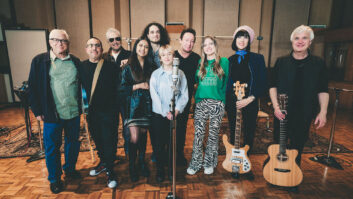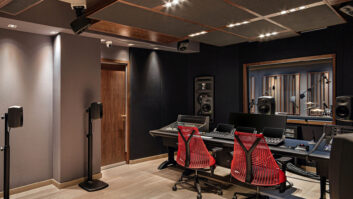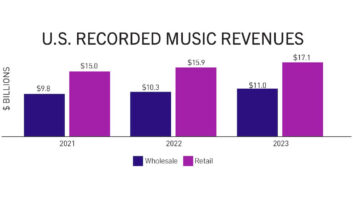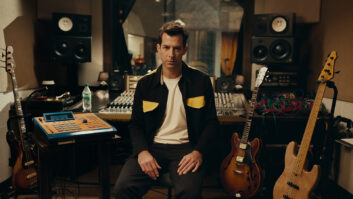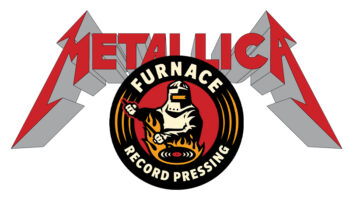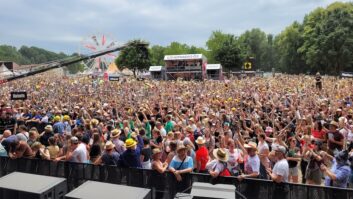Tierney Sutton’s upcoming CD, Dancing in the Dark is atribute to Frank Sinatra and was recorded at Conway Studios (Hollywood)for Telarc. Engineering tasks were handled by multiple GrammyAward-winner Michael Bishop.
Pictured: Four Sennheiser MKH 800s and a Neumann KU 100 handle thestring orchestra’s overdub session with Michael Bishop.
“The idea was to have Tierney record a collection of tunes that madeSinatra famous,” said Bishop. “‘Come Fly With Me,’ for example, is aswell-known for the Nelson Riddle arrangement as it is for Sinatra’simpeccable vocal. Having a female vocalist sing these songs turnsthings around right away. Another twist was the new arrangements byTierney and the band. Tierney has a fantastic band, and we started outrecording her and the trio live to DSD. We’ll add strings, winds andlight brass later as a DSD overdub.
“Our initial plans,” continued Bishop, “were to record the basics inStudio B over at Capitol Studios in Hollywood, where Sinatra worked.But Diana Krall and Tommy Li Puma were working in Studio A at the timewe were going to track, and their record was similar to ours, so itdidn’t quite feel right. We moved over to Conway, which is like arecording heaven! In this day and age, a lot of recording goes on inpersonal rooms and hole-in-the-wall studios that have Pro Tools rigsand there’s a certain sameness to lots of the releases. Only afirst-class facility with world-class tech support would cut it on thisproject. I always depend on a great room that will give us that certainedge in getting a unique sound. The bleeding-edge gear we use demandsthe best in studio support staff. Even though we were working with justa trio, I wanted to record in a large space in order to get the soundof the room into the recording.”
To capture the sounds of a grand piano, Bishop used a pair ofSennheiser MKH 800s on the Steinway Hamburg concert grand during thesessions. “How you mike a piano depends a lot on the nature of therecording itself,” said Bishop. “Classical recordings require movingmics out into the room. Close-miking is often used on jazz and poppiano recordings, but I wanted the option of moving the mics furtherout from the instruments for a bigger sound at times. Studio C over atConway is large enough to track a small orchestra in. I essentiallyused it as a piano room, but I was able to take advantage of the sizeof the space to help me capture the sound and body of the instrument,and the altitude as well, which gives some great colors. Recording theambience of the room itself is critical, as important, in fact, as theinstrument itself.” According to Bishop, this record will be releasedon SACD, as well as in the conventional CD format. “If you have anyshortcomings in the room, the microphones or in the signal chain,they’ll all be revealed on the high-resolution release, so we’reparticularly careful when we make recordings planned for thesespecifications.”
In addition to the 800s, Bishop placed a Neumann KU 100 behind themain mics for surround pickup. On the band tracks, the KU 100 was usedfor overheads and main pickup on the drums. For the string session, itfunctioned as surround pickup in addition to being a big part of thestereo sound. Bishop also relied on a Neumann Solution-D mic, which hehad previously used on Sutton’s last Telarc release, SomethingCool. “The principle attraction of the Solution-D is its extremetransparency,” he continued. “Tierney doesn’t need any help on hervoice. We don’t want to cover up or enhance her sound at all, and theSolution-D doesn’t impart any coloration. I use a very simple signalchain, in part because the Solution-D requires no external preamp. Wego straight from the Solution-D to a Prism DA2 converter—one ofthe best PCM D-As ever made—at 96 kHz. Then we hit a GML 8900dynamics controller, which handles some overall compression when it’sneeded. The D’s internal high-frequency limiting is great to have whenyou’re working extremely close to a vocalist and you have to worryabout sibilants.
“I control everything from my laptop in the control room. TheSolution-D software lets me send control data over the same AES cablethat the signal is coming into the control room on using the system’sAES 42 interface. I can change a pickup pattern or alter thesensitivity and gain, and insert high frequency and peak limitingwithout ever leaving the control room! All of these functions arecontrolled at the microphone itself. Add to that the openness and theclarity of the microphone, and you’ve got a fabulous combination, whichhas become an invaluable tool for me. I couldn’t imagine going into asession with a vocalist who has such a wide tonal range and using anyother mic but the Solution-D. I’ve tried all sorts of classicmicrophones on Tierney, but I haven’t found anything that beats theD.”
For more on the microphones, visit www.sennheiserusa.com or www.neumannusa.com.

